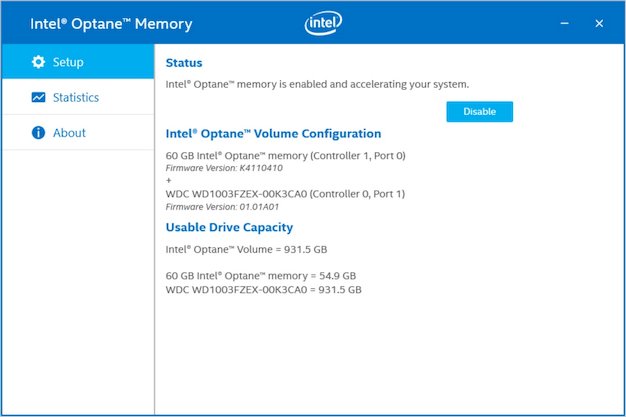Intel Optane Memory Update: Making Hard Drives Perform Like Fast SSDs
Intel Optane Memory Acceleration In Action
We showed you how Intel Optane Memory worked and performed in our initial coverage of the technology available right here. In this piece, we’re not going to re-hash any of our old data, but rather will show you how the newer 64GB Optane Memory device performs and how accelerating a secondary storage volume behaves.
For our testing, we used an Intel Core i7-8700K-based system with 16GB of RAM and a Gigabyte H370-based motherboard running Windows 10 64-bit. The OS was installed on a 118GB Intel Optane SSD, the secondary volume was a 1TB WD Black 7200RPM SATA hard drive, and the recently-released 64GB Optane Memory drive was used to accelerate the HDD.
Intel makes setting up Optane Memory a breeze. Provided you’ve got a compatible system and Optane Acceleration has been enabled in the BIOS, users simply have to install the driver package and click on Enable (or Disable) in the control the panel. The control panel will detect the Optane Memory device and present a drop down to select which other drive in a system to accelerate.
Once enabled, Optane Memory works transparently in the background and requires virtually no user interaction whatsoever.
Before we show you how Optane Memory accelerated the secondary volume in the system we should present some baseline performance.
This CrystalDiskMark score was recorded before any acceleration was enabled. It shows how the Intel Optane Memory drive performs on its own, operating as a standalone SSD.
On the left, we also have some numbers from the 1TB WD Black HD, again, before acceleration was enabled. As you can see, sequentials barely break 170MB/s and 4K transfers are extremely low versus an SSD. Finally, on the right, is how the secondary volume (notice, it is still drive D: with the same capacity) performs with Optane Memory technology enabled. Overall, performance in this benchmark looks similar to the standalone Optane Memory performance.
We have similar data for you here using the latest version of the ATTO Disk Benchmark. First up, we have some numbers with the Optane Memory device operating as a standalone drive. Reads peak at just shy of 1.4GB/s with writes in the 613MB/s range. IOs top out at approximately 110 – 114K.
Next are the transfer speeds and maximum IOs at various block sizes with the 1TB WD Black operating on its own, non-accelerated. As you can see, transfer speeds top out in in the 190MB/s range with peak IOs between 36-47K.
And finally, with Optane Memory acceleration enabled, the combined volume behaves very much like the standalone SSD. What you end up with is the full capacity of the HDD, with performance that mimics an SSD, at least when data being cached on the drive is being accessed.
For our testing, we used an Intel Core i7-8700K-based system with 16GB of RAM and a Gigabyte H370-based motherboard running Windows 10 64-bit. The OS was installed on a 118GB Intel Optane SSD, the secondary volume was a 1TB WD Black 7200RPM SATA hard drive, and the recently-released 64GB Optane Memory drive was used to accelerate the HDD.
Intel makes setting up Optane Memory a breeze. Provided you’ve got a compatible system and Optane Acceleration has been enabled in the BIOS, users simply have to install the driver package and click on Enable (or Disable) in the control the panel. The control panel will detect the Optane Memory device and present a drop down to select which other drive in a system to accelerate.
Once enabled, Optane Memory works transparently in the background and requires virtually no user interaction whatsoever.
Optane Memory Performance
Before we show you how Optane Memory accelerated the secondary volume in the system we should present some baseline performance.This CrystalDiskMark score was recorded before any acceleration was enabled. It shows how the Intel Optane Memory drive performs on its own, operating as a standalone SSD.
On the left, we also have some numbers from the 1TB WD Black HD, again, before acceleration was enabled. As you can see, sequentials barely break 170MB/s and 4K transfers are extremely low versus an SSD. Finally, on the right, is how the secondary volume (notice, it is still drive D: with the same capacity) performs with Optane Memory technology enabled. Overall, performance in this benchmark looks similar to the standalone Optane Memory performance.
We have similar data for you here using the latest version of the ATTO Disk Benchmark. First up, we have some numbers with the Optane Memory device operating as a standalone drive. Reads peak at just shy of 1.4GB/s with writes in the 613MB/s range. IOs top out at approximately 110 – 114K.
Next are the transfer speeds and maximum IOs at various block sizes with the 1TB WD Black operating on its own, non-accelerated. As you can see, transfer speeds top out in in the 190MB/s range with peak IOs between 36-47K.
And finally, with Optane Memory acceleration enabled, the combined volume behaves very much like the standalone SSD. What you end up with is the full capacity of the HDD, with performance that mimics an SSD, at least when data being cached on the drive is being accessed.

















